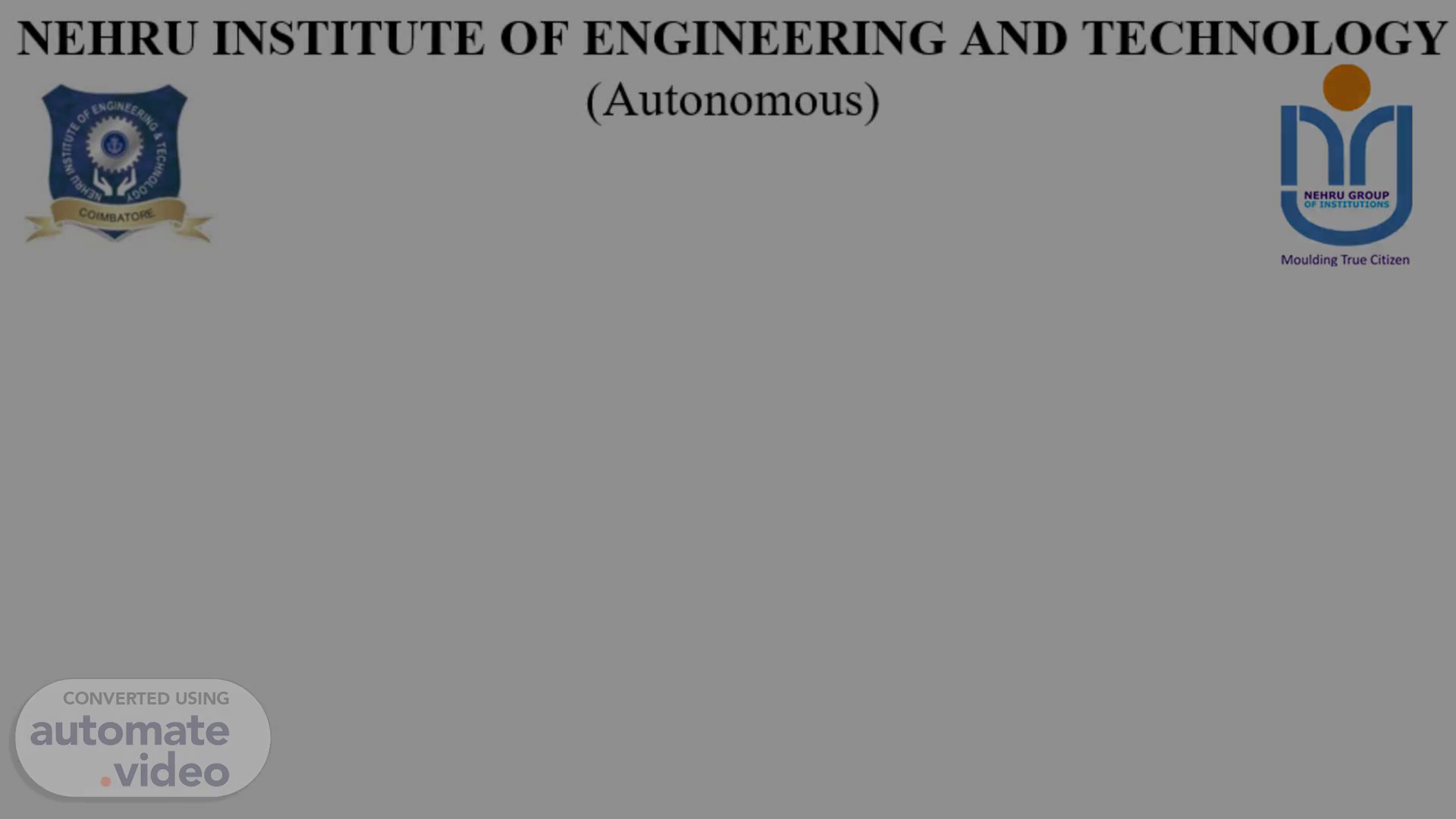Scene 1 (0s)
[Audio] NEHRU INSTITUTE OF ENGINEERING AND TECHNOLOGY (Autonomous) An ISO 9001:2015 and 14001:2015 Certified Institution, Affiliated to Anna University, Chennai, Approved by AICTE, New Delhi & Recognized by UGC with 2(f) & 12 (B), Re- accredited by NAAC “A+” NBA Accredited UG Courses: AERO| CSE| ECE| EEE| MECH| MCT Nehru Gardens, T.M. Palayam, Coimbatore- 641 105 MULTI-POSE HUMAN FACE MATCHING SYSTEM USING DEEP LEARNING AND YOLO-V5 Batch Number : 12 Internal Guide :Ms.S.Priya Batch Member & Reg. No.: M.Karthik-721421104032 (Team Leader) S.Manikandan-721421104034 M.Vicky-721421104059 M.Sethuram-721421104043 Computer Science and Engineering, Nehru Institute of Engineering and Technology 12-02-2025 Good day everyone. Today, we are presenting our project titled Multi-Pose Human Face Matching System Using Deep Learning and YOLO-V5. Our team comprises M. Karthik, S. Manikandan, M. Vicky, and M. Sethuram, under the guidance of Ms. S. Priya from the Computer Science and Engineering Department of Nehru Institute of Engineering and Technology..
Scene 2 (2m 28s)
[Audio] Abstract Human face matching across varying poses remains a significant challenge in the field of computer vision, especially for applications involving security, identity verification, and surveillance. This project presents a Deep Learning-based multi-pose human face matching system that leverages the YOLO-V5 (You Only Look Once) algorithm for efficient and accurate face detection and recognition across multiple poses. The system is designed to identify and match faces in diverse orientations, including front, left, right, down, and up poses, ensuring robust performance even under challenging viewing conditions The objective of our project is to address challenges in human face matching across varying poses, which is crucial in applications like security and identity verification. We introduce a deep learning-based system using the YOLO-V5 algorithm to efficiently detect and match faces across multiple orientations..
Scene 3 (3m 35s)
[Audio] Objective(s) To develop an efficient deep learning-based system capable of detecting and matching human faces across various poses (front, left, right, up, and down) using MATLAB and the YOLO-V5 algorithm. To ensure robust face detection and recognition under multi-pose conditions, enhancing the accuracy of face matching for applications in surveillance, authentication, and identity verification systems. To improve real-time performance for matching human faces across different angles and positions, minimizing false positives and negatives, and increasing the system's adaptability in dynamic environments. 12-02-2025 Our primary goals include developing a system capable of recognizing faces in multiple orientations, ensuring robustness in face detection, and improving real-time performance to reduce errors and enhance adaptability..
Scene 4 (4m 36s)
[Audio] Introduction Face recognition systems have gained significant attention in recent years due to their applications in security, surveillance, and authentication systems. However, traditional face recognition models often face challenges when dealing with variations in face poses, which can lead to decreased accuracy. To address this limitation, the proposed system introduces a Deep Learning-Based Multi-Pose Human Face Matching System using the YOLO-V5 algorithm for robust and efficient face detection and matching. This system leverages MATLAB image processing to detect and recognize human faces in various orientations, such as front, left, right, down, and up poses, ensuring that facial recognition is accurate even with pose variations. Traditional face recognition systems often struggle with pose variations. To overcome these limitations, we propose a deep learning-based system integrated with YOLO-V5 and MATLAB image processing to detect and recognize faces from various angles..
Scene 5 (5m 49s)
[Audio] Existing System and Disadvantages Description The existing method is presents a multi-pose facial expression recognition system based on a generative adversarial network (GAN) utilizing MATLAB for image processing. The GAN is designed to normalize and generate frontal facial expressions from multiple poses, allowing robust recognition across varied orientations. The system preprocesses facial images using landmark detection and alignment, followed by expression augmentation through the GAN. The generated frontal views are fed into a convolutional neural network (CNN) for classification into predefined emotion categories. 12-02-2025 Existing systems rely heavily on generative adversarial networks or GANs. While they can generate frontal views from multi-pose inputs, they suffer from training difficulties, mode collapse, inconsistency, and potential overfitting..
